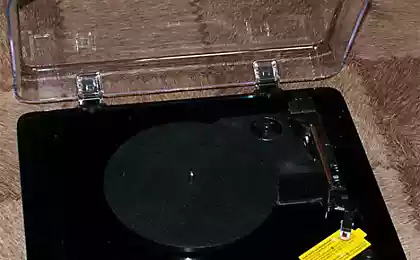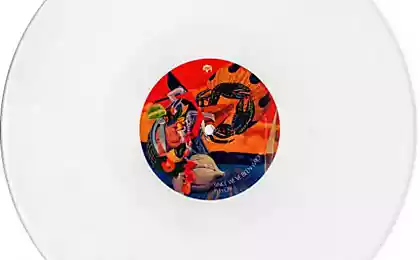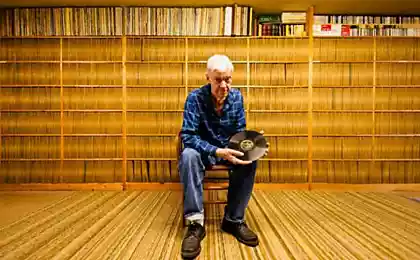922
Harsh reality or what is behind the return of vinyl
4,460,613
Note. pens.: today we decided to publish a translation of an interesting article about the realities of modern industry vinyl recordings. It is a material that is now listening on vinyl, who buy it and why it looks like modern records, and who today opens the business of their production. Incidentally, some of these plates in the article (and many other ) can be purchased in our store. I>
In the yard in 2014, and since we were talking about vinyl records, then we must talk about Jack Wight . In April this year, the self-proclaimed "RocknRolla" and supporter of analog audio noted Record Store Day in company with United Record Pressing in Nashville and in this regard issued the" fastest "plate in the world. At 10 am, White and his band recorded in his own studio Third Man live version of the title track from the new album Lazaretto i> , then the original recording went to United, where he was immediately replicated on the 7-inch press. By copies available in stores Third Man, to finish its way into the hands of fans. From start to finish the work took 3 hours 55 minutes and 21 seconds.
This was only the beginning for all the quirks White on the subject of vinyl. In June, he released the album Lazaretto i> on the plate with all kinds of bonuses and additions, which included additional "hidden" tracks, specially designed side A that plays backwards, side B with a matte finish, handcrafted hologram and more. Fans were delighted by such bonuses, which resulted in record sales: the album not only took first place in the charts, but also, according to Nielsen SoundScan, set a new record sales records in its first week, breaking the previous record, recorded in 1991. White has sold more than 40,000 copies of records Lazaretto in the first week.
This is great news for the industry vinyl. But not everyone shares this view.
"Every time I see a headline about the latest Jack White, it pisses me off," - said the studio, who wished to remain anonymous. "As long as he records albums for" one day ", customers can expect a normal week and not know at what stage is their order».
People are increasingly buying vinyl records. Last year, sales in the United States to overcome the bar at 6, 1 million copies. But while the demand for vinyl growing number of plants for its production in the United States remains unchanged. No one does not do so, because everyone thinks that the cost of building a factory prohibitive. Therefore, the industry is content with little more than a dozen factories operating in the territory of States. The biggest - is Nashville's United, the disposal of which 22 are of pressing machine, which produce between 30 000 and 40 000 plates per day. Compared with Nashville's United can Rainbo Records and Erika Records , located in California, which are also large enterprises. There are several medium-sized factories, such as California Record Technology, Inc. nine presses, and Gotta Groove Records six presses located in Cleveland. They produce about 4 000-5 000 plates per day. The producers with their own shops, such as Musicol in Columbus, Archer in Detroit and Palomino in Kentucky, the number of presses ranging from one to five. < br />
"Before, you could record an album in 4 weeks, - says John Beeler (John Beeler), Project Manager at Asthmatic Kitty , label created Sufenom Stevens ( Sufjan Stevens). - Now I tell my executors, that after the transfer of records to the factory, we need at least three months out to get ready to record. " What used to be a rarity and something abnormal, is now becoming the norm everywhere. "The process of writing the plate takes much more time than it took nine months ago," - says Nick Blandford (Nick Blandford), Managing Director of Secretly Label Group. It includes such well-known labels as Secretly Canadian , Jagjaguwar < / a>, and Dead Oceans , and group performers Bon Iver and the War on Drugs. Nick continues: "We are crossing their fingers and hoping that the situation will improve in April, after the Day of the music store, but everything remains the same. And we had to accept ».
Now that the industry vinyl records back to life, it was highly unlikely everyone is happy. And is in complete disarray.
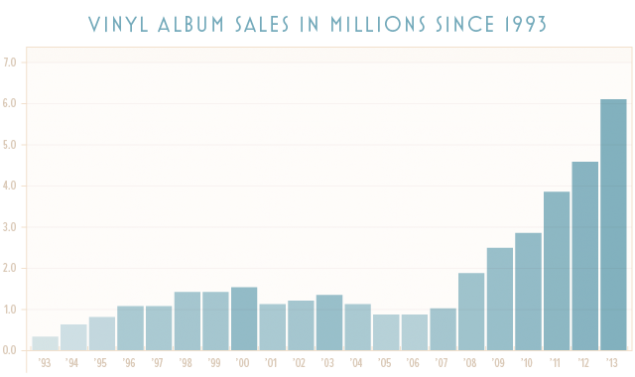
Vinyl began to come back to life in 2008, when its sales have increased by almost half compared to the previous year: 1 million copies to 1, 9 million. The number of copies has continued to grow from year to year and as a result was 6, 1 million copies in 2013, which is 33% more than 4, 6 million copies in 2012 (these figures will be much higher if we take into account the work that not ranked SoundScan). Market share in reviving the format is still much smaller than the CD, digital recording and streaming audio - it was only 2% of all album sales last year. The share of sales of digital records was 41%, while the proportion of CD's - 57%: nobody expected that vinyl capture a leading position. But the return to vinyl - it's more than just a temporary fashion trends, and in the near future this trend will continue. "Four years ago, only half of our records produced on plates - says James Cartwright (James Cartwright), Production Manager at Merge Records , - now as each of our work is available on vinyl ».
If we arrange all the records that are available today, next to each other on a giant wall in front of you there kaleidoscope, as a significant portion of all records sold is produced in color. While some purists argue that the limited releases and exclusives for the Day of the music store is a parody of the classic album, after communicating with employees Pressing Factory, recording studios and music stores becomes clear that such musicians as Jack White, give people something what they want. Along with the growth in sales of vinyl growing demand for exclusives. Musicol store in Columbus, Ohio, at its two presses produces vinyl since 1960, before the production of black vinyl occupied 90% of the time, but now half of all orders - a colored vinyl. A factory Gotta Groove Records, which opened four years ago in Cleveland, produces about 40% of its plates of colored vinyl.
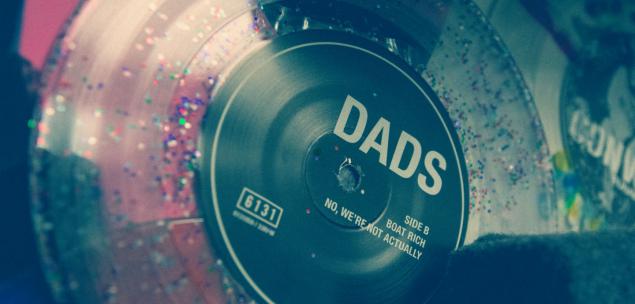
just pressed 7-inch plate with sequins from Gotta Grove Records. Hereinafter photo of Mary Robinson (Mara Robinson) i>
And White is not the only one who is invested in fancy decoration plates. At a recent change in working Gotta Groove shiny particles covers the floor around the machine on which they were created 100 records at a rotation speed of 45 rev / min, made of transparent plastic with an embedded glitter. The walls of the listening room there coated with various customer orders, among which we can find an impressive and even stunning specimens. One group is pressed into a plate of freshly ground coffee. Another ash particles have burnt the Bible of the 19th century. In one of the upcoming orders will need to be pressed into the plate shredded money. Factory had to take drastic measures and refuse customers when orders started coming in to use in the manufacturing process plates bodily fluids. "Not more than a month ago, one group asked to make a record with their blood," - said the vice president of sales and marketing Gotta Groove Matt Earley (Matt Earley), who always says "no».
Now you can decide what to add to the blood and coffee in the vinyl - this is a sign that the format was officially released at the brink of cultural goods and became some tchotchke - and in the world there are several groups that agree with this. Beeler from Asthmatic Kitty says that some of the artists with their fashion label resist on colored vinyl and a variety of exclusives. But Asthmatic Kitty still engaged in this, as required by the demand and limited editions such move sales. (Such exclusives often do not come to wholesalers and music stores, and are sold directly to the online store recording studio).
"We produce more colorful plates than ever," - says Matt Lunsford (Matt Lunsford), co-founder of Polyvinyl Records , which also belong to Japandroids and Montreal. At the moment, Polyvinyl been producing limited edition ready earlier albums. They also engaged in production of plates with drawing on them images and 7-inch plates for those who pre-order - all the records, plan to release this year, were reserved for only a month.
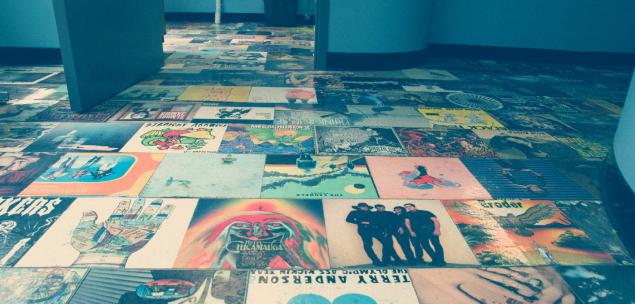
Sex in the lobby Gotta Groove, nestled covers plates i>
And who is buying? Anecdotally, but contingent is very different. During my recent visit to the store Lost Weekend Records , owner Saygrist Kyle (Kyle Siegrist) helped three customers choose vinyl records for themselves and their fathers, as a gift for Father's Day. I guess it all started somewhere twenty years ago, when the loyal fans still buy vinyl records and said: "Children do not understand." Then, about five years ago, the younger generation started buying vinyl, which greatly surprised their parents, and now they all go to the same music stores.
Mark Weinstein (Marc Weinstein), 57-year-old co-founder of the California chain of stores Amoeba Music , saw many of his friends blew the dust from their players when they learned that the second half of the decade vinyl sales have doubled. A younger generation buys records as contemporary artists, as well as "classics." ("Children in schools still listen to Bob Marley and Pink Floyd, and most likely always will listen", - told me in confidence Blandford). Demographics suggest that teenagers are buying vinyl. "I'm training wrestling team in high school - says Leo DeLuca (Leo DeLuca), Managing Director Misra Records , located in Dayton - and when newcomers come to buy players, they ask, do not release me vinyl. "
Vinyl lovers are unique in their buying habits. In the first week of June, right before Jack White has cracked the charts and has enticed a lot of fans on their side, Sharon Van Etten with his latest work Are We There i>, together with the label Jagjaguwar, ranked second in the vinyl charts, selling 2,115 records of all 8930 implemented on the week. This means that more than 20% of records sold in the first week after the operation singer or composer - this is true for most number of works published in the studio Secretly Label Group.
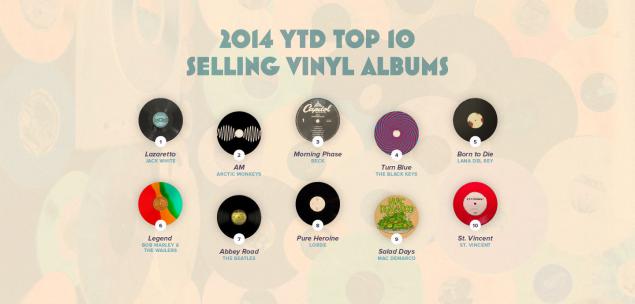
Top 50 albums of the year, issued before June 1 were different variations of rock: indie rock, alternative rock, folk-rock, classic rock, so, yes, vinyl is still the format of rock music. Several works of hip-hop artists diluted charts, such as Kendrick Lamar with good kid: mAAd city i> 18 th, The College Dropout i> Kanye West at the 45th and Wu-Tang Clan with Enter the Wu-Tang (36 Chambers) i> exactly 59 place, but even in these rap albums felt a hint of indie. Daft Punk also stood out with his album, Random Access Memories i>, Miles Davis work Kind of Blue i>, and popular radio and Justin Timberlake Lorde. The rest of the favorites are indie and alternative rock (Vampire Weekend, Mumford & Sons, Arctic Monkeys, Bon Iver, Beck, Neutral Milk Hotel), the flagship of classic rock (the Beatles, Pink Floyd, Bob Marley), and all three of the last album Black Keys, which attracted fans as indie and classic rock. Chart can be used as an outline for the course of indie rock classics and recent past 40-50h of the 20th century.
"If the album became the musical heritage, it will listen to over and over again," - says Blandford. This can happen not only hits the 60s and 70s, but also with the work of young musicians. "If you had told me that we will sell nearly 100,000 copies of their debut album, Bon Iver For Emma, Forever Ago i> in 2007, I would consider it an absolute madness».

About 40% of all records in Gotta Grove are in color i>
Retail outlets lay hopes not only on Record Store Day, which is a pass to the world of vinyl for younger buyers, but also on the cards for downloading music, coming with new vinyl records as a stimulant demand. Such an approach does not seem pointless, given another habit of young buyers who shops and recording studios did not foresee. Not so long ago, located in London ICM Research conducted a исследование and found that 15% of those people who buy music on physical media, such as CD-ROM, vinyl records and tapes, never let them listen - they buy them only that they have been.
"Customers who are not fans of analog music formats, but simply want to support your favorite artists have been underestimated - says Blandford - they want to put something on my shelf, something that they or their friends can see - to it reflects their hobbies. "
Weinstein of Amoeba recalls that in the past when vinyl was the most popular format, then everyone in the house was an altar favorite music - stereo, speakers and stand with plates, ostentation - now the altar there, and the young lovers of vinyl. "It allows you to find new topics of conversation - says Weinstein, - a demonstration of their tastes - it is a way to show that is important to you."
In 2014, the opportunity to always keep the plate in the presence becomes a trivial task for music stores. One of the "dirty" secrets retail - that wholesalers allow them to return unsold CD, but not vinyl. If the shop owners will buy too much of some instance, they will eventually begin to reduce the price on it and do not get any profit. If the order is too small, the store also lose profits. Independent shops still compete with online retailers who supply goods endless. If the store ran out copies of the new album War on Drugs (what happened in many stores this year), it is likely, people will get it online. Once again the store gets the party plates, potential buyers are returning. Until the advent of the platelets in the shop can take weeks or even months, of the fact that their creation factory takes a long time.
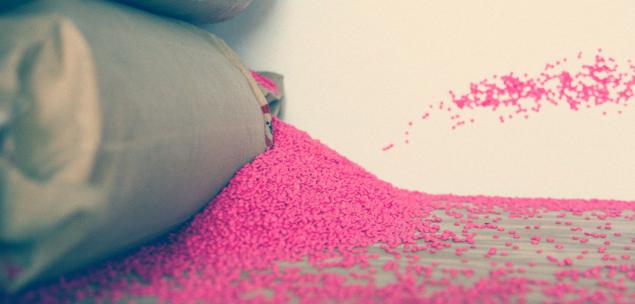
A bunch of PVC granules, which are melted and pressed for the creation of records in Gotta Groove i>
Creation of vinyl records - is more art than science. CD-disks simply replicate and produce records with zero PVC granules and paper labels that are part of a multi-stage process that does not tolerate mistakes. When 57-year-old Vince Slusharts (Vince Slusarz), the owner of Gotta Groove Records in Cleveland, has launched a factory in 2009, his first record he created two weeks. "We had no idea what we were doing," - he said.
Slusharts did not contemplate, he wanted to start producing plate. As a former production manager and part-time lawyer, he knew he wanted to open his own business in Cleveland, but had no idea what kind of business. "I've always loved music, and at the end of 2008, I saw my eldest daughter buys vinyl records - says Slusharts - this influenced my decision».
Slusharts began looking for equipment, but could not find anything suitable. He was ready to give up in despair, and wrote a letter to the four factories for the production of plates with the question whether they have something to sell. Two did not respond. One did not sell. But the fourth - Sun Plastics in Newark, New Jersey, was going to sell his business, and was planning to vacate their space in two months. Slusharts flew to Jersey, made a deal, and in March 2009 the equipment was shipped in four truck trailers to make the perilous journey to Ohio (one press fell and was damaged on the way).
Even after five years, the production of vinyl is able to present Gotta Groove few surprises. In the company there are 6 machines, and is now recovering another one that came from the famous Boddie Recording Company , based in Cleveland.
Source: geektimes.ru/company/audiomania/blog/243065/
Note. pens.: today we decided to publish a translation of an interesting article about the realities of modern industry vinyl recordings. It is a material that is now listening on vinyl, who buy it and why it looks like modern records, and who today opens the business of their production. Incidentally, some of these plates in the article (and many other ) can be purchased in our store. I>
In the yard in 2014, and since we were talking about vinyl records, then we must talk about Jack Wight . In April this year, the self-proclaimed "RocknRolla" and supporter of analog audio noted Record Store Day in company with United Record Pressing in Nashville and in this regard issued the" fastest "plate in the world. At 10 am, White and his band recorded in his own studio Third Man live version of the title track from the new album Lazaretto i> , then the original recording went to United, where he was immediately replicated on the 7-inch press. By copies available in stores Third Man, to finish its way into the hands of fans. From start to finish the work took 3 hours 55 minutes and 21 seconds.
This was only the beginning for all the quirks White on the subject of vinyl. In June, he released the album Lazaretto i> on the plate with all kinds of bonuses and additions, which included additional "hidden" tracks, specially designed side A that plays backwards, side B with a matte finish, handcrafted hologram and more. Fans were delighted by such bonuses, which resulted in record sales: the album not only took first place in the charts, but also, according to Nielsen SoundScan, set a new record sales records in its first week, breaking the previous record, recorded in 1991. White has sold more than 40,000 copies of records Lazaretto in the first week.
This is great news for the industry vinyl. But not everyone shares this view.
"Every time I see a headline about the latest Jack White, it pisses me off," - said the studio, who wished to remain anonymous. "As long as he records albums for" one day ", customers can expect a normal week and not know at what stage is their order».
People are increasingly buying vinyl records. Last year, sales in the United States to overcome the bar at 6, 1 million copies. But while the demand for vinyl growing number of plants for its production in the United States remains unchanged. No one does not do so, because everyone thinks that the cost of building a factory prohibitive. Therefore, the industry is content with little more than a dozen factories operating in the territory of States. The biggest - is Nashville's United, the disposal of which 22 are of pressing machine, which produce between 30 000 and 40 000 plates per day. Compared with Nashville's United can Rainbo Records and Erika Records , located in California, which are also large enterprises. There are several medium-sized factories, such as California Record Technology, Inc. nine presses, and Gotta Groove Records six presses located in Cleveland. They produce about 4 000-5 000 plates per day. The producers with their own shops, such as Musicol in Columbus, Archer in Detroit and Palomino in Kentucky, the number of presses ranging from one to five. < br />
"Before, you could record an album in 4 weeks, - says John Beeler (John Beeler), Project Manager at Asthmatic Kitty , label created Sufenom Stevens ( Sufjan Stevens). - Now I tell my executors, that after the transfer of records to the factory, we need at least three months out to get ready to record. " What used to be a rarity and something abnormal, is now becoming the norm everywhere. "The process of writing the plate takes much more time than it took nine months ago," - says Nick Blandford (Nick Blandford), Managing Director of Secretly Label Group. It includes such well-known labels as Secretly Canadian , Jagjaguwar < / a>, and Dead Oceans , and group performers Bon Iver and the War on Drugs. Nick continues: "We are crossing their fingers and hoping that the situation will improve in April, after the Day of the music store, but everything remains the same. And we had to accept ».
Now that the industry vinyl records back to life, it was highly unlikely everyone is happy. And is in complete disarray.

Vinyl began to come back to life in 2008, when its sales have increased by almost half compared to the previous year: 1 million copies to 1, 9 million. The number of copies has continued to grow from year to year and as a result was 6, 1 million copies in 2013, which is 33% more than 4, 6 million copies in 2012 (these figures will be much higher if we take into account the work that not ranked SoundScan). Market share in reviving the format is still much smaller than the CD, digital recording and streaming audio - it was only 2% of all album sales last year. The share of sales of digital records was 41%, while the proportion of CD's - 57%: nobody expected that vinyl capture a leading position. But the return to vinyl - it's more than just a temporary fashion trends, and in the near future this trend will continue. "Four years ago, only half of our records produced on plates - says James Cartwright (James Cartwright), Production Manager at Merge Records , - now as each of our work is available on vinyl ».
If we arrange all the records that are available today, next to each other on a giant wall in front of you there kaleidoscope, as a significant portion of all records sold is produced in color. While some purists argue that the limited releases and exclusives for the Day of the music store is a parody of the classic album, after communicating with employees Pressing Factory, recording studios and music stores becomes clear that such musicians as Jack White, give people something what they want. Along with the growth in sales of vinyl growing demand for exclusives. Musicol store in Columbus, Ohio, at its two presses produces vinyl since 1960, before the production of black vinyl occupied 90% of the time, but now half of all orders - a colored vinyl. A factory Gotta Groove Records, which opened four years ago in Cleveland, produces about 40% of its plates of colored vinyl.

just pressed 7-inch plate with sequins from Gotta Grove Records. Hereinafter photo of Mary Robinson (Mara Robinson) i>
And White is not the only one who is invested in fancy decoration plates. At a recent change in working Gotta Groove shiny particles covers the floor around the machine on which they were created 100 records at a rotation speed of 45 rev / min, made of transparent plastic with an embedded glitter. The walls of the listening room there coated with various customer orders, among which we can find an impressive and even stunning specimens. One group is pressed into a plate of freshly ground coffee. Another ash particles have burnt the Bible of the 19th century. In one of the upcoming orders will need to be pressed into the plate shredded money. Factory had to take drastic measures and refuse customers when orders started coming in to use in the manufacturing process plates bodily fluids. "Not more than a month ago, one group asked to make a record with their blood," - said the vice president of sales and marketing Gotta Groove Matt Earley (Matt Earley), who always says "no».
Now you can decide what to add to the blood and coffee in the vinyl - this is a sign that the format was officially released at the brink of cultural goods and became some tchotchke - and in the world there are several groups that agree with this. Beeler from Asthmatic Kitty says that some of the artists with their fashion label resist on colored vinyl and a variety of exclusives. But Asthmatic Kitty still engaged in this, as required by the demand and limited editions such move sales. (Such exclusives often do not come to wholesalers and music stores, and are sold directly to the online store recording studio).
"We produce more colorful plates than ever," - says Matt Lunsford (Matt Lunsford), co-founder of Polyvinyl Records , which also belong to Japandroids and Montreal. At the moment, Polyvinyl been producing limited edition ready earlier albums. They also engaged in production of plates with drawing on them images and 7-inch plates for those who pre-order - all the records, plan to release this year, were reserved for only a month.

Sex in the lobby Gotta Groove, nestled covers plates i>
And who is buying? Anecdotally, but contingent is very different. During my recent visit to the store Lost Weekend Records , owner Saygrist Kyle (Kyle Siegrist) helped three customers choose vinyl records for themselves and their fathers, as a gift for Father's Day. I guess it all started somewhere twenty years ago, when the loyal fans still buy vinyl records and said: "Children do not understand." Then, about five years ago, the younger generation started buying vinyl, which greatly surprised their parents, and now they all go to the same music stores.
Mark Weinstein (Marc Weinstein), 57-year-old co-founder of the California chain of stores Amoeba Music , saw many of his friends blew the dust from their players when they learned that the second half of the decade vinyl sales have doubled. A younger generation buys records as contemporary artists, as well as "classics." ("Children in schools still listen to Bob Marley and Pink Floyd, and most likely always will listen", - told me in confidence Blandford). Demographics suggest that teenagers are buying vinyl. "I'm training wrestling team in high school - says Leo DeLuca (Leo DeLuca), Managing Director Misra Records , located in Dayton - and when newcomers come to buy players, they ask, do not release me vinyl. "
Vinyl lovers are unique in their buying habits. In the first week of June, right before Jack White has cracked the charts and has enticed a lot of fans on their side, Sharon Van Etten with his latest work Are We There i>, together with the label Jagjaguwar, ranked second in the vinyl charts, selling 2,115 records of all 8930 implemented on the week. This means that more than 20% of records sold in the first week after the operation singer or composer - this is true for most number of works published in the studio Secretly Label Group.

Top 50 albums of the year, issued before June 1 were different variations of rock: indie rock, alternative rock, folk-rock, classic rock, so, yes, vinyl is still the format of rock music. Several works of hip-hop artists diluted charts, such as Kendrick Lamar with good kid: mAAd city i> 18 th, The College Dropout i> Kanye West at the 45th and Wu-Tang Clan with Enter the Wu-Tang (36 Chambers) i> exactly 59 place, but even in these rap albums felt a hint of indie. Daft Punk also stood out with his album, Random Access Memories i>, Miles Davis work Kind of Blue i>, and popular radio and Justin Timberlake Lorde. The rest of the favorites are indie and alternative rock (Vampire Weekend, Mumford & Sons, Arctic Monkeys, Bon Iver, Beck, Neutral Milk Hotel), the flagship of classic rock (the Beatles, Pink Floyd, Bob Marley), and all three of the last album Black Keys, which attracted fans as indie and classic rock. Chart can be used as an outline for the course of indie rock classics and recent past 40-50h of the 20th century.
"If the album became the musical heritage, it will listen to over and over again," - says Blandford. This can happen not only hits the 60s and 70s, but also with the work of young musicians. "If you had told me that we will sell nearly 100,000 copies of their debut album, Bon Iver For Emma, Forever Ago i> in 2007, I would consider it an absolute madness».

About 40% of all records in Gotta Grove are in color i>
Retail outlets lay hopes not only on Record Store Day, which is a pass to the world of vinyl for younger buyers, but also on the cards for downloading music, coming with new vinyl records as a stimulant demand. Such an approach does not seem pointless, given another habit of young buyers who shops and recording studios did not foresee. Not so long ago, located in London ICM Research conducted a исследование and found that 15% of those people who buy music on physical media, such as CD-ROM, vinyl records and tapes, never let them listen - they buy them only that they have been.
"Customers who are not fans of analog music formats, but simply want to support your favorite artists have been underestimated - says Blandford - they want to put something on my shelf, something that they or their friends can see - to it reflects their hobbies. "
Weinstein of Amoeba recalls that in the past when vinyl was the most popular format, then everyone in the house was an altar favorite music - stereo, speakers and stand with plates, ostentation - now the altar there, and the young lovers of vinyl. "It allows you to find new topics of conversation - says Weinstein, - a demonstration of their tastes - it is a way to show that is important to you."
In 2014, the opportunity to always keep the plate in the presence becomes a trivial task for music stores. One of the "dirty" secrets retail - that wholesalers allow them to return unsold CD, but not vinyl. If the shop owners will buy too much of some instance, they will eventually begin to reduce the price on it and do not get any profit. If the order is too small, the store also lose profits. Independent shops still compete with online retailers who supply goods endless. If the store ran out copies of the new album War on Drugs (what happened in many stores this year), it is likely, people will get it online. Once again the store gets the party plates, potential buyers are returning. Until the advent of the platelets in the shop can take weeks or even months, of the fact that their creation factory takes a long time.

A bunch of PVC granules, which are melted and pressed for the creation of records in Gotta Groove i>
Creation of vinyl records - is more art than science. CD-disks simply replicate and produce records with zero PVC granules and paper labels that are part of a multi-stage process that does not tolerate mistakes. When 57-year-old Vince Slusharts (Vince Slusarz), the owner of Gotta Groove Records in Cleveland, has launched a factory in 2009, his first record he created two weeks. "We had no idea what we were doing," - he said.
Slusharts did not contemplate, he wanted to start producing plate. As a former production manager and part-time lawyer, he knew he wanted to open his own business in Cleveland, but had no idea what kind of business. "I've always loved music, and at the end of 2008, I saw my eldest daughter buys vinyl records - says Slusharts - this influenced my decision».
Slusharts began looking for equipment, but could not find anything suitable. He was ready to give up in despair, and wrote a letter to the four factories for the production of plates with the question whether they have something to sell. Two did not respond. One did not sell. But the fourth - Sun Plastics in Newark, New Jersey, was going to sell his business, and was planning to vacate their space in two months. Slusharts flew to Jersey, made a deal, and in March 2009 the equipment was shipped in four truck trailers to make the perilous journey to Ohio (one press fell and was damaged on the way).
Even after five years, the production of vinyl is able to present Gotta Groove few surprises. In the company there are 6 machines, and is now recovering another one that came from the famous Boddie Recording Company , based in Cleveland.
Source: geektimes.ru/company/audiomania/blog/243065/
SpaceX going to plant the first stage of the Falcon 9 to "barge"
Telepresence robots in the California store sell themselves


